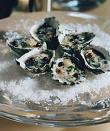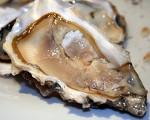Late last month I sat down with ten colleagues at the Water Grill in downtown Los Angeles and was told to consume as many  oysters as I could in one sitting. The occasion was the Pacific Coast Oyster Wine Competition held each year by Taylor Shellfish Farms of Shelton, WA, and presided over by a benevolent, thoroughly unflappable old salt named Jon Rowley. Rowley conducts the competition in three cities on the West Coast, using only domestic white wines, with experts scoring the ‘bliss’ factor. To his credit, he does not define bliss (a pretty personal thing for all present) but seems confident that we’ll know it when we feel it, or taste it, or smell it. About fifteen wines induce enough bliss annually to be crowned best of show.
oysters as I could in one sitting. The occasion was the Pacific Coast Oyster Wine Competition held each year by Taylor Shellfish Farms of Shelton, WA, and presided over by a benevolent, thoroughly unflappable old salt named Jon Rowley. Rowley conducts the competition in three cities on the West Coast, using only domestic white wines, with experts scoring the ‘bliss’ factor. To his credit, he does not define bliss (a pretty personal thing for all present) but seems confident that we’ll know it when we feel it, or taste it, or smell it. About fifteen wines induce enough bliss annually to be crowned best of show.
 Jon Rowley seems to operate at a slightly different speed than the rest of us. He speaks slowly, in soft and measured tones, and his parsimony is such that it seems he’s weighing his words with extreme care. In this he resembles his great oyster muse, Ernest Hemingway, whom he loves to quote, beautifully and at length, from A Moveable Feast at the opening of each competition:
Jon Rowley seems to operate at a slightly different speed than the rest of us. He speaks slowly, in soft and measured tones, and his parsimony is such that it seems he’s weighing his words with extreme care. In this he resembles his great oyster muse, Ernest Hemingway, whom he loves to quote, beautifully and at length, from A Moveable Feast at the opening of each competition:
As I ate the oysters with their strong taste of the sea and their faint metallic taste that the cold white wine washed away, leaving only the sea taste and the succulent texture, and as I drank their cold liquid from each shell and washed it down with the crisp taste of the wine, I lost the empty feeling and began to be happy and to make plans.
As for the task at hand, I know what you’re going to say. ‘What a life,’ you’ll sneer, ‘It’s a dirty job, but someone has to do it,’ etc., etc., but I have to say that it’s not as easy as it sounds. (All right, now you’re breaking out the world’s smallest violin.) At a restaurant on a Friday night with a bottle of cool-vintage Chablis in the ice-bucket, slurping with a loved one, when the sensuality of eating oysters is aligned with the sensuous bustle of a busy bistro–that, to me, practically defines bliss. (Each year, by the way, my wife is VERY unhappy when this assignment rolls around.)
When oysters are work, though, they aren’t quite as fun as when you’re eating them out on the town. (Okay, they’re still pretty fun.) But just having to think about oysters–to wrap your head around what they are, and what they aren’t, what they taste like, that that taste has very few corollaries in the universe of things to eat, and the fact that their mouthfeel is, at best, confusing, mysterious, and seductive–and at worst, seriously queasy-making.
Rowley also instructed us, counter to habit, not to smell the wine  we were judging, but to just taste it. (We could smell the oyster if we wanted.) Oysters, in other words, were the focal point. But oysters have no focal point. Oysters have attributes so subtle and diffuse, so centerless, that if the idea is to follow your bliss, you’re going to have a hard time picking a direction.
we were judging, but to just taste it. (We could smell the oyster if we wanted.) Oysters, in other words, were the focal point. But oysters have no focal point. Oysters have attributes so subtle and diffuse, so centerless, that if the idea is to follow your bliss, you’re going to have a hard time picking a direction.
And when you add wine, it’s even weirder. Bliss, where present, comes from neither the oyster or the wine, it comes from that middle ground where solid meets liquid, where salt meets sweet, where fruit meets whatever it can brush up against, in that gorgeous snotpuddle quivering in its shell.
For the record, these particular snotpuddles were unbelievably delicious, fine kumamotos farmed in a remote, unpopulated inlet on the Baja Peninsula happily called Rancho Bueno–they tasted sweet and fine like coldwater kumos, but with perhaps a little warm-water musk to their scent, and quite a bit more brine to the flavor.
 So: You smelled your oyster. You placed your oyster in your mouth in a somewhat awkward shell-tipping slurping sucking lip-grabbing action. Depending on your preference, you chewed, tongued, ground or otherwise masticated your oyster, where its flavor started to fill and coat the mouth. You took a sip of ice-cold wine, and contemplated the notion of bliss. And then you spat.
So: You smelled your oyster. You placed your oyster in your mouth in a somewhat awkward shell-tipping slurping sucking lip-grabbing action. Depending on your preference, you chewed, tongued, ground or otherwise masticated your oyster, where its flavor started to fill and coat the mouth. You took a sip of ice-cold wine, and contemplated the notion of bliss. And then you spat.
Let’s just get this out of the way: Wine and only wine is up to the task. Ice cold dry white wines not only have the exact tone to meet with the oyster, but a good oyster wine will seem to gather the oyster from its dreamy, creamy vagueness and give it some shape. The combination isn’t overly forceful or authoritative; the oyster isn’t so much centered as collected: still nebulous, but now the nebulae have an outline. And within the frame, there seem to be actual points at which the wine shakes hands with the oyster:
Wine, meet oyster.
Hello, oyster.
Oyster, meet wine.
Hello, wine.
And depending on the wine, the handshake is entirely different.
The Sauvignon Blancs, for example. We tasted a number of simple, delicious Sauvignons from California and Washington State and the range of flavor in those wines, from green-herb to citrus and melon, brought out different qualities. The herbaceous wines seemed to strike at a green point in the oyster, at, say, the seaweed or algae or microscopic flora the animal had ingested. Green found green, in other words. In other Sauvignons, the citrus flavors may as well have been a spritz of lemon on the oyster, or zest of lime. More saline Sauvignons brought out the oyster’s salty, tangy, seashell-y minerality.
Other wines, like the Pinots Blanc and Gris, had slightly more body and slightly more fruit, and that fruit–let’s place it in a crisp apple spectrum–would tend to crash over the oyster flavor almost like a wave, washing over and for a moment obscuring the creamy saline sensation, only to recede itself and have that flavor return to your mouth.
Some wines had an almost biscuity scent, which for some reason seemed to waft into the flavor of the oyster as well, a kind of  po’boy effect. In fact there was a fair amount of bliss all around, except for three categories, all of which are increasingly common in domestic wine: oak, residual sugar, and high alcohol. Oaked whites simply work at cross purposes with an oyster. Save those for bigger, more elaborate meals. Sweet wines act more like a flood than a wave, and the oyster is swept away, never to reappear. High alcohol, on the other hand, works like some unpleasant magic act, distorting the delicate flavor, then nuking it with an Everclear heat.
po’boy effect. In fact there was a fair amount of bliss all around, except for three categories, all of which are increasingly common in domestic wine: oak, residual sugar, and high alcohol. Oaked whites simply work at cross purposes with an oyster. Save those for bigger, more elaborate meals. Sweet wines act more like a flood than a wave, and the oyster is swept away, never to reappear. High alcohol, on the other hand, works like some unpleasant magic act, distorting the delicate flavor, then nuking it with an Everclear heat.
And that is the thing to remember above all. These wines will be mirrors, and so simplicity is the order of the day. The least flashy wines, the wines that don’t blow you out of the water or knock you over the head might be the most successful of all. Think clean, think light, think pure. Remember what the gurus say: Purity is the pathway to bliss.
2006 Simi Sonoma County Sauvignon Blanc ($21): Lean, fine, and mineral, this fresh-tasting wine has a nice high tone that sings with the oysters. 89
2006 Chateau Ste. Michelle Columbia Valley Sauvignon Blanc ($11): This clean Washington State wine has a saline, sea air quality that picks up on a fresh oyster’s salty pool in the shell. Just a touch of melon fruit couches the oyster nicely. 90
2006 Robledo Family Winery Lake County Seven Brothers Sauvignon Blanc ($18): From cool Lake County, this classic Sauvignon leads with pretty melon fruit and a hint of grassiness, which locks into the seaweedy element of the oyster. 90
2006 Amity Vineyards Willamette Valley Pinot Blanc ($17): Nice citrusy scent with a fine lean grapefruit flavor, even a bit of pith. The zippy, slightly mineral acidity makes it an ideal oyster wine. 88
2006 Di Bruno Santa Rita Hills Sanford & Benedict Vineyard Pinot Grigio ($20): My number 1 wine, this Grigio closely resembled a Sancerre or Touraine Sauvignon Blanc in its citrus zest aromas and chalk-laden minerality. Bliss. 91
2006 Willamette Valley Vineyards Willamette Valley Pinot Gris ($15): Crisp apple flavors with a hint of lemony citrus give the oyster some very pleasant lift; the flavor intermingles with a delightful freshness. 90
